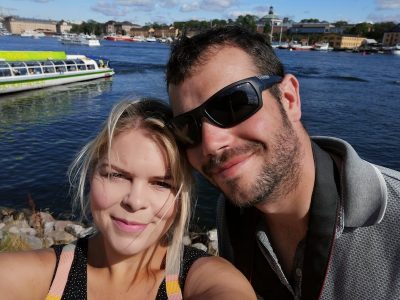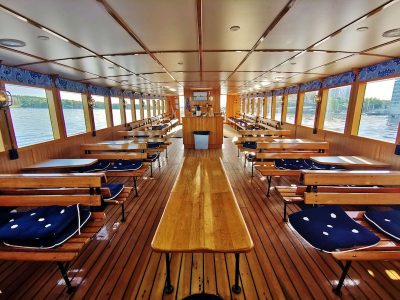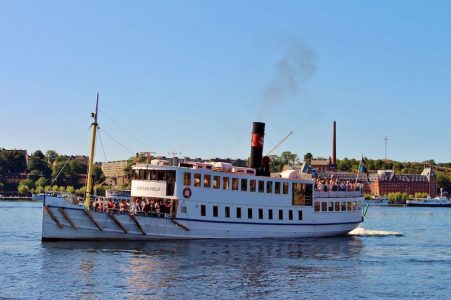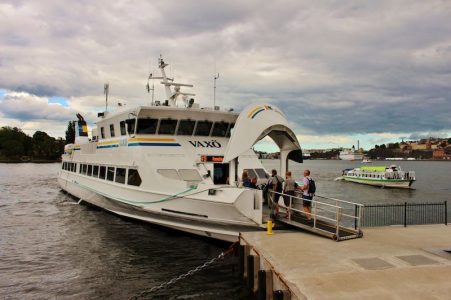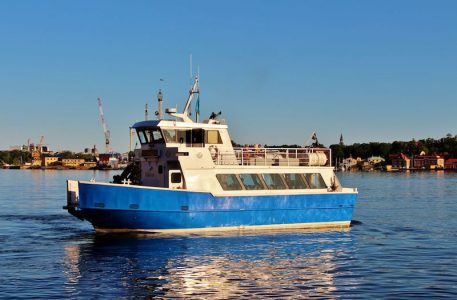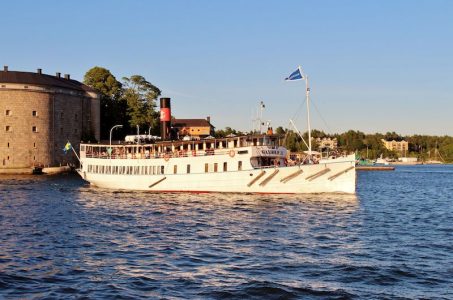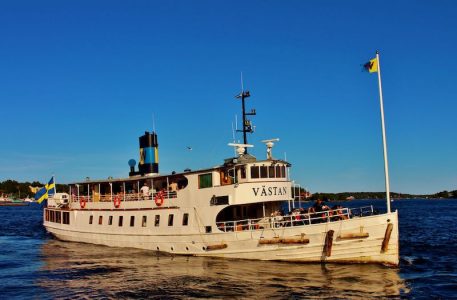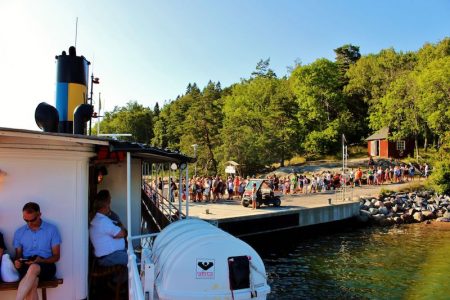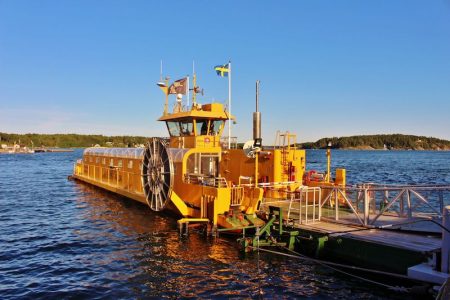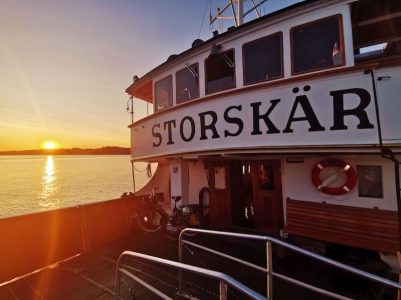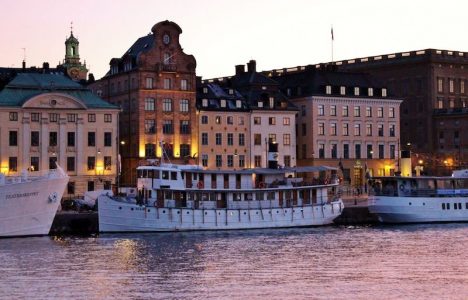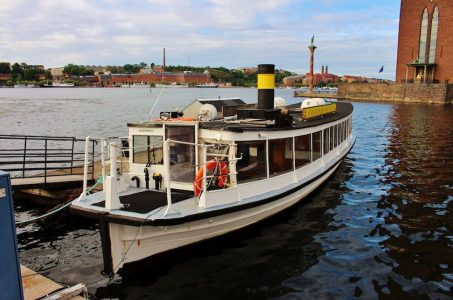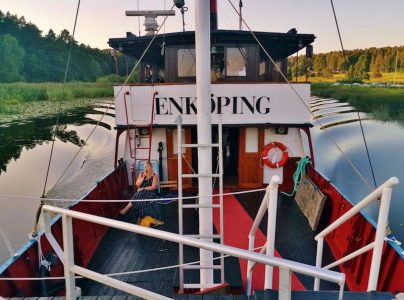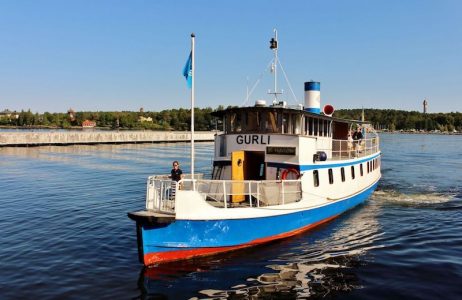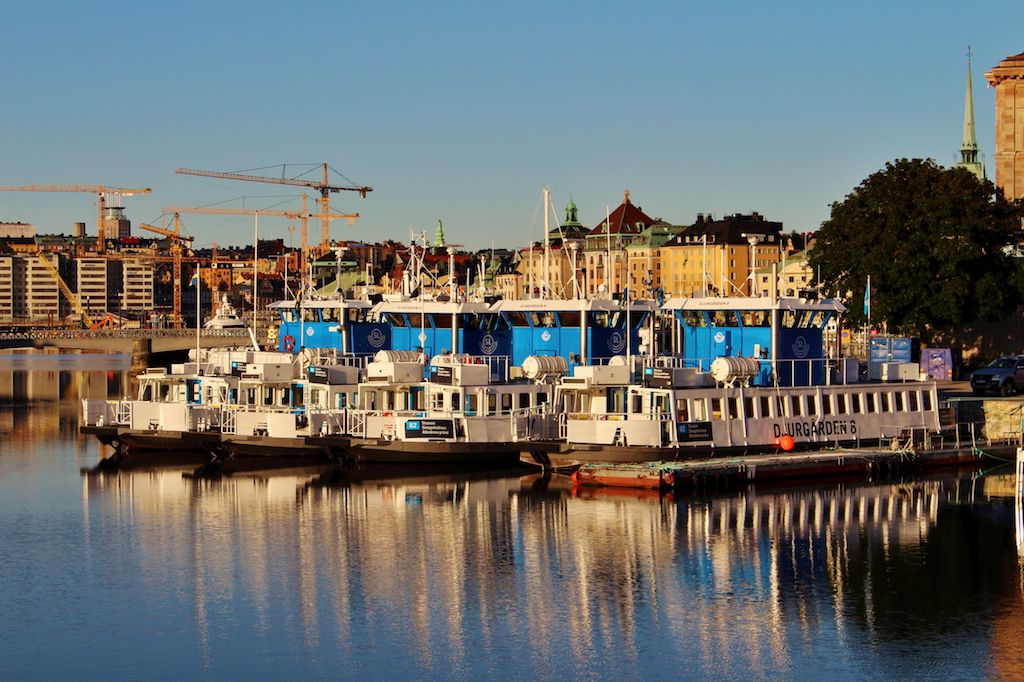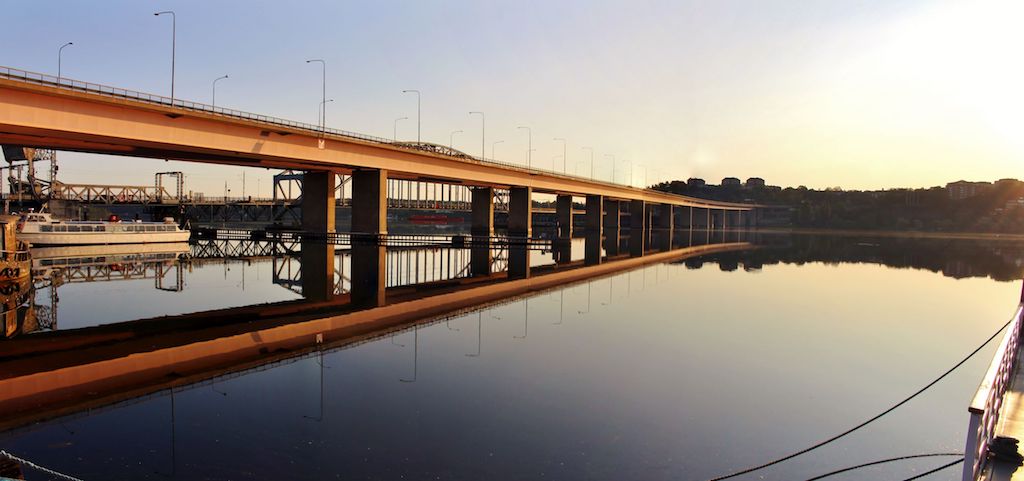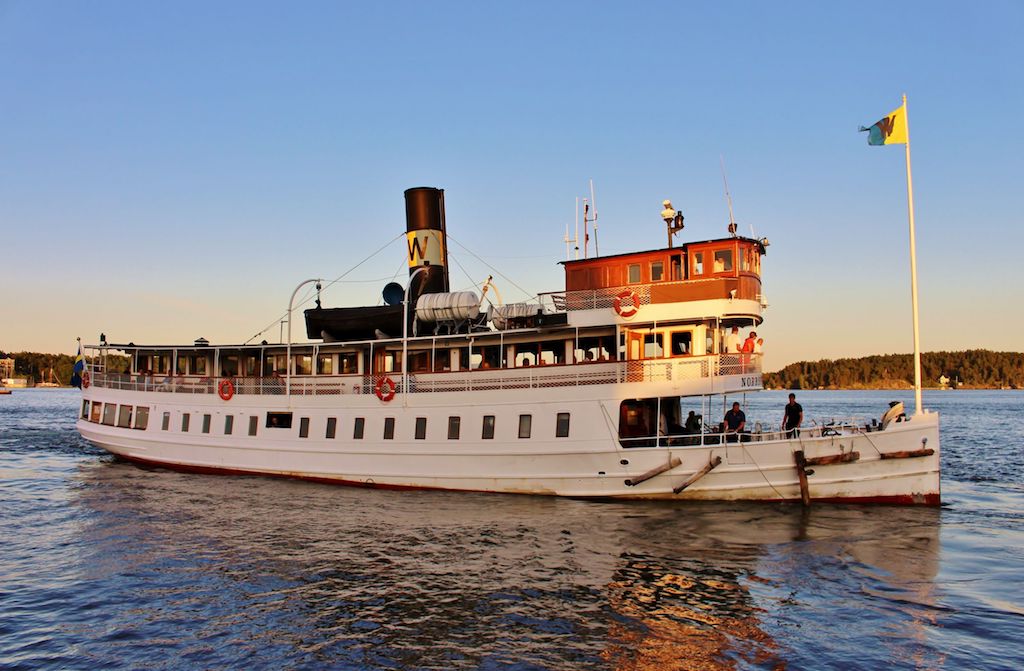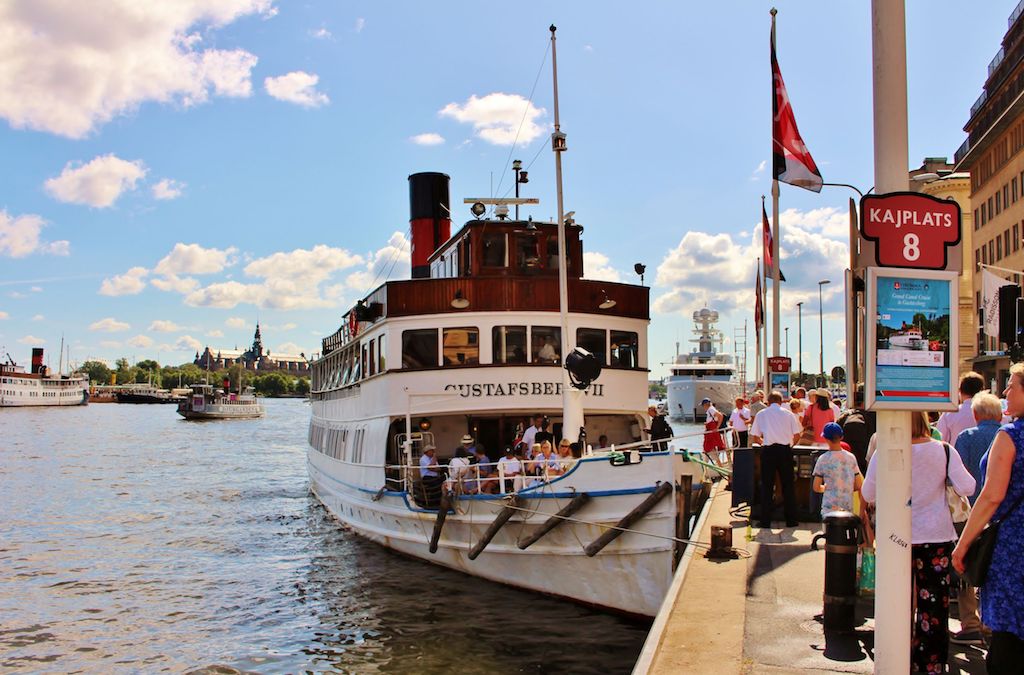
This way for steamer dreamers: Gustafsberg VII, one of the many old-timers operating in and around Stockholm, awaits excursionists at a city-centre quay. Rob Beale describes the Swedish capital as a ‘shipping paradise’
Rob Beale spends most of his waking hours in command of the various Windermere lake steamers. So, when he and his wife Kim recently headed to Stockholm on holiday, surely it was the museums, the shopping, the restaurants and the café life that they wanted to explore together? Well, bravo Kim for going along with this busman’s holiday. Here is her husband’s Stockholm diary. Photos are all © Rob Beale.
When my wife booked a holiday to Stockholm with no kids, my first thought was about what a relaxing week we would have, strolling through foreign streets sampling local culinary delights and cultural sights. Then I looked at a map of Stockholm and the surrounding area.
Stockholm is a city built on islands, surrounded by more islands, which in turn have more islands beyond them. In short, it is a shipping paradise. A network of local ferries buzz around the harbour and nearby islands while the larger ferries head out to the archipelago.
Then there’s the huge international ships that link Stockholm with Finland, Estonia, Åland, Latvia and Russia, and almost daily there’s one or two cruise liners arriving at Stockholm, either near the Viking Line terminal or up at Frihamnen.
The problem was which boats did I want to travel on, and which routes too. I started researching. When looking into boat trips and Stockholm, the first company you find is Stromma – a company I have used before in Copenhagen where I found them to be professional, but busy.

First vessel on Rob’s itinerary: Djurgården 4 (1897), steam-powered until 1969, runs for free to the nearby island of Djurgården, where the Gröna Lund amusement park, Skansen open-air museum and zoo and Vasa Maritime Museum are situated
A quick look at their web page showed me that they use a fleet of heritage archipelago excursion vessels for longer trips, and more modern waterbuses for the local hop-on hop-off services.
We also had a travel card for all Stockholm Public Transport services (SL) which include their three commuter ferry services, Lines 80, 82 and 89. As these were free with the travel card they were a ‘must do’! A trip out to the further reaches of the archipelago was also a ‘must’, but there were so many options, many provided by Stromma, that I just couldn’t decide which to do — except one, Enköping, the oldest commercial passenger ship in the world dating from 1868. I wasn’t going to miss that one!
It was only after a few more days surfing the web that I found Waxholmsbolaget – the council-run passenger ships that go out to the islands. Many of the islands can be reached by car if you travel north from the city and work your way across the islands, or around long indented coastlines, but passenger services from the centre of Stockholm are still a very popular way to travel.

‘An elegant vessel with plenty of outside space, and a fully accessible open bow with chairs to relax on and soak up the view’: built in 1900 and converted to diesel in 1967, Västan arrives at Stromkajen
There are two main harbours in Stockholm: Nybrokajen and Stromkajen. Stromma depart from the former, and Waxholmsbolaget from the latter. Nybrokajen is also often referred to as Nybroplan in many of the timetables.
The Waxholmsbolaget fleet consists of a variety of vessels including V-Boats which are modern, fast vessels that tend to make a couple of trips to the outer islands and back each day. Three ships in the fleet caught my eye: Västan (built in 1900), Storskär (1908) and Norrskär (1910). The latter two are steam vessels and all three are in use daily during the summer.
My list of vessels I just had to travel on was getting larger. It didn’t stop there either. Among the vessels deployed on the commuter ferry Line 80 are Gurli (1871) and Kung Ring (1902). There are more but I’ll come to them later. The big problem facing me was how was I to try and fit all this in on a holiday which my wife was expecting to be a very relaxed affair, with lots of long lie-ins.
Well, there was my opportunity. While my wife slept, I would head out early to travel on the various routes and vessels! Don’t get me wrong, she’s happy to travel on the boats with me, but going backwards and forwards along the same route, for the sake of getting on different ships, just isn’t her cup of tea!
I am in the passenger boat trade myself and enjoy seeing how other companies do it, from their berthing procedures through to their uniforms and timetable layouts. Stromma timetables were simple. Waxholmsbolaget’s, by contrast, are grouped into island areas, but one boat may travel through part or all of a number of island groups, meaning that trying to track a boat through the myriad of timetables can become quite a challenge.
Thankfully AIS has made this task easier, enabling me to plan a number of different excursions and make the best use of time, while also allowing me to travel on a variety of routes and vessels.
So, after arriving at Arlanda airport and taking the very fancy Arlanda Express train into the centre of Stockholm (Day 1), we dumped our bags at the hotel and headed straight for Nybroplan, one of two inner city harbours where the ships come and go constantly. What a place! As we had arrived late in the day, some of Stromma’s day excursion vessels were back in port — and what a fine sight they looked.
Östanå I (1906) and Stockholm (1931) were loading for another trip out to the archipelago, whilst the all-electric Sjövägen of 2014 was boarding for a trip to Nacka Strand on Line 80. The two rival hop-on hop-off companies (Stromma and Red Sightseeing) were vying for space at the harbour wall.
But our first vessel was Djurgården 4, built in 1897 and steam-powered until 1969.
She and her sister Djurgården 7 (1893) run for free to the nearby island of Djurgården, where the Gröna Lund amusement park, Skansen open-air museum and zoo and Vasa Maritime Museum are.
After a few hours of thrills at the theme park we got her much newer fleet-mate, Djurgården 8 (1977), across to Slussen on the council’s frequent Line 82 service. This 300-passenger vessel crosses the harbour in about 12 minutes: the run is so busy that sometimes three or four vessels are in use. Once at Slussen we watched Juno (1874) landing after her four-day journey across the country from Gothenburg along the Göta Canal. She would depart again for the return journey the next day at 9am.
Day 1 done, and only two boats managed so far! Day 2 was where my plan started to come into action.
Up at 5.45am, I took the metro to the outskirts and then a bus to a place called Tappström on the island of Ekerö. This was not in the archipelago, but the east side of Stockholm opens out into the huge Lake Mälaren, which has a surface area of 440 square miles.
At 7.20am I boarded Lux (2019), launched in April this year from the yard of Kewatec Aluboat at Karleby in Finland. Most commuter ferries serving capital cities of the world head through canals or house-lined rivers, but this one heads down a lush narrow channel which opens out into the lake proper, before calling first at the green island of Kungshatt.
From there we wound into the heart of the city via a few more stops, finishing at Klara Mälarstrand at 8.15.
This well-appointed vessel was quiet and had plenty of bike space to promote ‘green’ commuting.
I took advantage of the coffee and the large open upper deck. At the berth in Stockholm, the beautiful Mariefred of 1903 was getting up steam for her 10-hour day trip to the town of the same name. Unfortunately she would not feature in any of my sails this week
Alongside Mariefred were five more Stromma vessels. The steamer Drottningholm (1909) and motor ships Prince Carl Philip (1901) and Angantyr (1909) were readying for the extremely popular trips to the royal palace at Drottningholm. Evert Taube (1976) and Malar Victoria (1984) would soon head off to Skokloster and Birka respectively. The little Sjöfröken (1875) caught my eye and I added her to my list for the week.
After rejoining Kim for breakfast we visited a number of museums using the hop-on hop-off service. From the Royal Palace at Slottet we caught Delfin VII (1960) to the Vasa Museum.
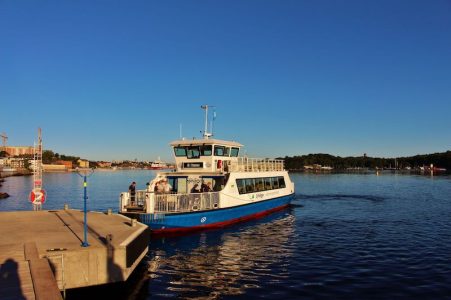
Sjövägen of 2014 at Kvarnholmen — a fully electric vessel which charges at set points throughout the day. ‘It was a glorious sail on a mirror-like sea’, says Rob
The boats used on this hop-on hop-off service are small, hot and not suited to the huge number of customers that use them. People were left behind at a number of piers, and the only really interesting thing about them is the way they load over the bow.
Most of the modern vessels in the city and nearby islands don’t use conventional piers. Boarding points are on the bow and the vessel simply runs into the berthing area carefully and keeps pushing ahead whilst passengers disembark and embark.
Later in the day we caught the similarly busy Delfin VIII (1940) from the Vasa Museum to Djurgården (also known as Allmänna Gränd), and then decided to swap to the council ferries as they were more spacious and had open deck areas.
Djurgården 8 was our last vessel for Day 2, once again from Djurgården to Slussen.
●
Day 3 was the big day out to the archipelago.
The plan was to get Gustafsberg VII (1912) from Stockholm through a narrow channel to Gustavsberg, which looked a very scenic and interesting trip. From there a bus would take us to Norra Lagnö, from where we would continue by local ferries to Vaxholm, allowing us to pick up the three historic Waxholmsbolaget vessels to cruise around the islands.
But before all that, I headed out early, to travel along the commuter ferry Line 80 and hopefully travel on Gurli (1871). At 5.55am I was on the quayside at Nybroplan where I boarded Sjövägen of 2014. A fully electric vessel which charges at set points throughout the day, she is the first boat out in the morning and the last one back at night. It was a glorious sail on a mirror-like sea and it was almost eerie, as no other vessels moved in the usually bustling harbour.
On the way we passed Viking Grace (2013) on her way in from Turku and Åland. She is rather striking due to her large rotary sail towering above her top deck. Sjövägen took me as far as Kvarnholmen.
This was where Gurli was meant to pick me up, but a quick look at AIS informed me that she hadn’t left her overnight berth yet. For the previous few weeks, whenever I checked AIS, she had always operated this run. Instead, the rather uninteresting Hattan (1984) was making her way towards me. Not to worry, I still had a few more days to try and catch Gurli. I sailed on Hattan and then Namdofjard (1986) before I had the pleasure of sailing out to Frihamnen on Kung Ring (1902).
This 117-year old vessel was immaculate and I partook of the free coffee available on all SL commuter ferries and enjoyed the scorching sun – and it was still only 7.45 am!
Past Nacka Strand, the bay opened out a bit and I got my first taste of the archipelago and what was hopefully to come later in the day. I debated whether or not to return to Stockholm Nybroplan with Kung Ring as it was such a pleasant morning, but then remembered I had to get tickets for the first part of our island hopping day I had planned.
A very smart tram dropped me back at Nybroplan three hours after I had departed on Sjövägen. Walking along the quayside I photographed Motala Express (1895), which has had an interesting history. Built for services on Lake Vattern she had the nickname of the ‘prisoner of Vattern’ because she was too big to use the locks to leave the lake.
●

Motala Express of 1895 operates evening charter cruises to the islands, still powered by her original steam engine.
But in 2010 she had her bow section cut off so she could leave the lake after 115 years for a new life in Stockholm. Following restoration of her bow, she now operates evening charter cruises quite regularly out to the islands. She is also still powered by her original steam engine.
I joined the queue at the Stromma office, and while standing waiting for it to open, Kung Ring returned. I should have stayed aboard! Anyway, as soon as I had bought tickets for the cruise aboard Gustafsberg VII, I returned to the hotel to start the day as a couple!
On board Gustafsberg VII we slipped out of the berth at 11am sharp and headed south out of the harbour on the two-hour journey to Gustavsberg. This fine ship was built for the Gustavsberg porcelain factory to transport their products to and from the city. She later became a passenger steamer and was only converted to a motor ship in 1985.
Unfortunately, about eight minutes after our departure it became clear all was not well: we ground to a halt in the middle of the busy shipping lane. Announcements from the captain kept us informed that engineers were on their way to have a look at the engine which could not be restarted. We drifted ever more slowly towards Viking Cinderella (1989), berthed at the international terminal, and after about an hour we were ignominiously shoved onto an unoccupied part of the terminal by Delfin XII (1972).
My original plan had us waiting in Gustavsberg for nearly two hours before the bus to Norra Lagnö, so I could afford to wait a bit to see if they fixed the ship. Unfortunately it was a further 40 minutes before the engineers arrived, by which time my plan was starting to fall apart. I asked to leave the vessel, but because we were berthed at the international terminal, past passport control, we were not allowed to leave.
The engineers eventually got us going at about 1.15pm and, amazingly, the captain was all set to continue the day trip as planned. I again asked to get off, as did a number of other passengers, and eventually we were dropped off at Kastellholmen, a rare berth for any passenger vessel in Stockholm.
This happened too late for my Plan B, which was to get the bus direct to Norra Lagnö. So it was on to Plan C. I just hadn’t thought of it yet!
As we walked along the harbour I noticed Västan making her way in to town. Here was Plan C. The original plan had us picking up Västan out in the islands at 4.15pm, so why not just get on her now?
She was due to depart at 3pm so we headed to her berth and queued up in the 28-degree sun. We were amongst the first to board, and found seats along the starboard side in the sun to enjoy the trip.
She was very busy out to Vaxholm, and on the way we passed my next two targets for the day, the steamers Storskär and Norrskär. We made a few calls at small islands on the way to Vaxholm, but from there out to the further islands Västan was much quieter, allowing me to get a good look around this veteran. Launched in 1900 for services on Lake Mälaren, east of Stockholm, she moved to the archipelago trade in the mid 1930s.
Converted from steam to diesel in 1967, she is an elegant vessel with plenty of outside space, and for those in Scotland who mourn the slow demise of the ‘bow view’ that is disappearing from the Caledonian MacBrayne fleet, she – as do all the heritage vessels in Stockholm – has a fully accessible open bow with chairs to relax on and soak up the view.
Inside she has a wooden décor and rather a rather plush saloon on the upper deck.
From Vaxholm on to Södra Grinda we really felt that we were heading out to sea. The channels between the islands got larger and the islands were less populated, but still had many lovely shoreside residences. We passed many other ferries, cruise liners and yachts.
The interesting cable ferry Vaxholmen (1980), which plies between Vaxholm and the small offshore island with the Vaxholm Fort on, was berthed as we passed, but once we were clear we saw her slowly starting to wind her way across to the island.
Shortly after, Eskil (1989) came charging past on her way back to Stockholm from Sandhamn. Operated by Stromma, Eskil is one of four boats that are advertised as the ‘Cinderella Boats’. The fleet includes Cinderella I (1990), Cinderella II (1989), Askungen (1991) and Eskil.
These fast vessels make a couple of trips a day each to the outer archipelago but are pricier than the Waxholmsbolaget fleet, and are less interesting to the enthusiast. It was noted, however, that every Cinderella boat I saw on the holiday was full! They also make less calls at the smaller islands, which is half the fun for someone like me.
Onwards we ploughed, making calls at Edholma, Halleberg, Skärmaräng, Vårholma and Sippsö. The route took us across the deep water channel the cruise ships and international ferries use and we saw Silja’s Galaxy (2005) on her way in from Turku. The queue waiting to board at Södra Grinda was enough to stop me popping off for a quick photo, which proved to be a good decision as we ended up leaving people behind who were picked up by another Waxholmsbolaget vessel passing that way, which made an extra call.

The heritage vessel Norrskär of 1910 is still powered by her original 350hp Eriksberg steam engine, which is available to view through the engine room hatch
Most of these passengers were day-trippers who had been dropped off at the island by Västan’s morning trip. Passing Storskär heading out on her evening cruise, we retraced our journey to Vaxholm, where we disembarked – another good decision, as it was by now around 6.30pm and Västan was again full on her journey to Stockholm.
We had an hour to wait until our trip to Ramsö on Norrskär but it passed quickly. While we munched on our Swedish hot dogs, seven vessels came and went, including Waxholm III of 1903. She operates for Stromma on an 11-hour day trip right out around the extensive archipelago.
I very nearly booked her trip but realised I wouldn’t get the vessel variety I wanted. Admittedly we would have seen a lot more of the islands, but sometimes small sacrifices must be made.
Also, her cruise would have cost us over £200, whereas our Waxholmsbolaget day cost only around £40 for both of us!
Norrskär duly arrived from the south, made a brief stop at Vaxholm and allowed us to board. The vessel was quiet and it was a pleasure to be aboard a real steamer once again. She gave three blasts as she manoeuvred away from the berth and then turned to the east for Ramsö and the short 20-minute crossing. We found our place beneath the bridge overlooking the bow and enjoyed a well-earned refreshment.
Norrskär was built for the run she still serves today at weekends — that from Stockholm to Vaxholm, Södra Grinda, Gällnö and Sandhamn. She was actually named Sandhamns Express until 1949 when she took he present name. She is still powered by her original 350hp Eriksberg steam engine, which is available to view through the engine room hatch. On arrival at Ramsö we had a 20-minute lay over. My wife enjoyed the sun, I disembarked to take photos and some of the other passengers actually took to jumping in to the water from the top deck to cool down in the still scorching heat!
We made our way back to Vaxholm in what was turning out to be a stunning sunset, and on arrival at Vaxholm the steamer dreamer in me didn’t know which way to look! To port, the steam-powered Bildosund (1911) was taking an evening music cruise from Stockholm. She was closely followed by the diesel Vindhem (1971) on a shrimp cruise, whilst to starboard Stromma’s Stockholm (1931) was also circling to berth at Vaxholm on her evening dinner cruise.
This vessel still has her original steam machinery but rarely uses it except for special occasions. Usually she is powered by her two Volvo Penta diesel engines.
The light made for a scene to savour, and I snapped away like a mad man, even as we stepped ashore from Norrskär to allow her to return to Stockholm.
We only had half an hour to wait for our final vessel of the day. Storskär came in from the north and we boarded for the last leg of her schedule back to Stockholm Stromkajen. As the penultimate sailing of the day back to the city from Vaxholm she wasn’t too busy.
Storskär dates from 1908 and was also built for services on Lake Mälaren to Strangnas. She moved to the archipelago trade in the 1940s and is powered by a 659hp Lindholmen steam engine.
It was a truly memorable evening, particularly when we came back into the city — the sky was nearly purple and Gröna Lund’s thrill rides were all lit up.
As we turned back in to Stromkajen we noticed that Diana (1931) had landed at the same berth occupied by her sister Juno the previous day. Diana also serves as a cruise liner along the Göta Canal. It was going to be hard to make day 4 beat that!
Next day (Day 4) I shelved my plans for an early start and allowed myself to lie in. We only managed three vessels today but they had a combined age of 417, and an average age of 139! For starters we sauntered down to Klara Mälarstrand where the Stromma fleet that heads into Lake Mälaren berths.
We watched the impressive fleet get ready for the day but it was the little Sjöfröken that we made a beeline for. This 1875 vessel operates the ‘Historic Canal Cruise’ around Kungsholmen Island — an interesting 50 minutes, especially when we passed the multitude of houseboats along the way, many of them with the look of retired archipelago boats. It was also a bit of an ‘eye opener’ cruise as there were many locals sunbathing the Scandinavian way as we cruised around. I had to be careful where I pointed my camera!
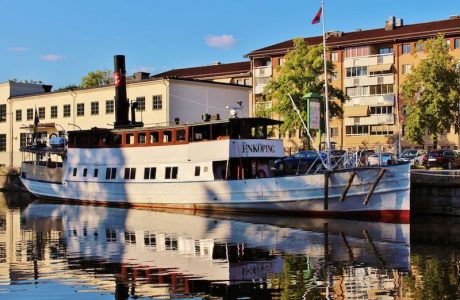
Enköping of 1868 is the oldest passenger ship on Lloyds register and apparently the oldest commercial passenger ship in the world
After so many boats we decided to stay on land for a bit and headed off to do a few more museums, but we did get to the first of these by way of Djurgården 4.
But it was our evening itinerary that I had long been looking forward to.
At 5.30pm we caught the double decker train to Uppsala and then ambled down to the River Fyris, which has been canalised through the town.
The excursion ship Kung Carl Gustaf (1892) was loading up for her 6.30pm departure for a dinner cruise. Beyond her was my target vessel, one that for years I had wanted to get a photo of, let alone sail on: Enköping of 1868.
She is the oldest passenger ship on Lloyds register and apparently the oldest commercial passenger ship in the world, i.e. not funded by donations or staffed by a crew of at least some volunteers.
During the day she sails down to Skokloster which, if we had done it, would not have allowed much time for anything else. We were booked for her three-hour shrimp dinner cruise, which would take us down the River Fyris into the northern reaches of Lake Mälaren.
Enköping looks like your typical early archipelago boat. There are a number of similar vessels still around but, obviously, none quite as old. She has a raised forepeak and an open bow well-deck from where you enter the main saloon.
Through the saloon are the toilets and access to the large open sided rear deck and there, on the back deck are the stairs to the upper saloon. This room was laid out for dinner on our trip and looked wonderful.
Access to the wheelhouse is made either from a ladder from the front well deck, or from a door behind the bar. Enköping was originally powered by a 110hp Oskarshamn steam engine, but since 1948 has been diesel powered.
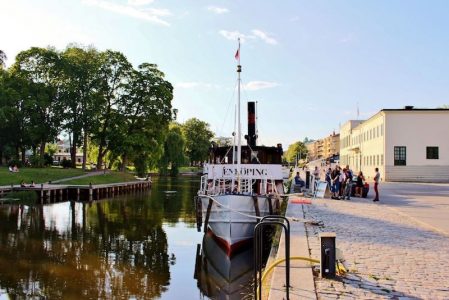
Enköping is ‘your typical early archipelago boat’, but her shrimp-dinner cruise had a unique flavour
As her name suggests her original intended route was that across Lake Mälaren from Stockholm to Enköping, but she has had a varied career under a variety of names.
Once we had finished shelling our prawns, we moved from the saloon to the bow and just soaked up the scenery. It was a surprisingly long haul to the lake proper under a number of bridges which either pivoted or slid out of our way to let us glide by. We avoided the local children swimming in the river and emerged out onto the northernmost tip of Lake Mälaren.
The skipper then decided to take us west and up into a small bay that rarely sees the passenger boats, but afforded us the most wonderful sunset. All too soon it was time to turn and head back up the glassy waters to Uppsala where we berthed again just before 10 pm. That was it then. We were heading home the next day, but I still hadn’t managed to get a trip on the Gurli.
Regretting not getting up early the previous day, I decided to get up at 4.45am on the last day (Day 5) and get the underground to Ropsten. Here I boarded the Delfin X (1966), which is owned by Stromma but operates for Waxholmsbolaget to the islands of Tranholmen and Storholmen. I was the only passenger aboard when at 6.05am we slipped our berth under the Ropsten Bridge and turned north on waters which were still as a millpond. As we sailed under the bridge I looked behind to see that Baltic Princess (2008) was just landing at Frihamnen at the end of her voyage from Finland via the Åland islands.
Delfin X is a former sightseeing vessel but, despite her spaciousness, she is rather uninteresting. Nevertheless, her commuter route was glorious in the morning sun. We sped out to the first stop at Tranholmen, where the crew reset the sign used to call the boat in, which had been left set since the previous night. Then we made three calls in an anti-clockwise direction around Storholmen.
It was while sailing around the island that I checked my AIS app and noticed that Gurli was once again sailing on the commuter run Line 80. I formulated a plan to make her my last sailing of the holiday. Delfin X conveyed me back to Ropsten along the same route and once there I hastily made my way back to the underground for the short journey to Nybroplan. Here I boarded the Emelie (1931) which, along with her sister Emelie II (1967), operates the private ferry between Stockholm City, the Viking Terminal and Hammarby Sjöstad. I had wanted to travel on one of these ships because, on every trip into the city, one of the two vessels had been coming or going whilst we were there. I disembarked at the Viking Terminal and hot-footed it over to Finnboda Hamn to see Gurli just going past.
Thankfully she was still on her outward sailing to Kvarnholmen and would be back with me in around five minutes. Just made it!
Built in 1871 Gurli must be the oldest commuter ferry in the world. She usually operates daily from 6.20am until around7 pm. Her career looks set to continue as at the end of summer the Stockholm Transport Authority are proposing to join Lines 80 and 81 and increasing services due to popularity.
Similar to Kung Ring (on which I sailed earlier in the week), Gurli has a wood-panelled interior with stairs in the centre of the saloon leading to the top deck. A rather unnerving sign on the stairs reads “Max of 27 people on sundeck…If we are more than 27 people up on sundeck we risk the ship’s stability.”
Thankfully there were only 13 people there so I continued on up. Gurli was motorised in 1964 and from looking at past images it is obvious she has had major modifications over her 148-year career. She is still a fine little boat to sail on, and she made a fitting finale to my boating in Stockholm.
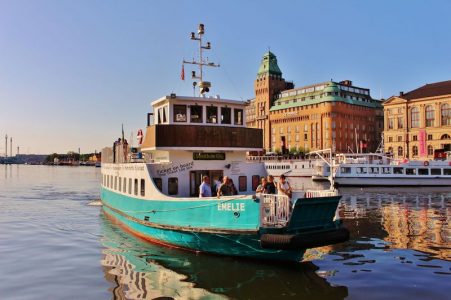
Emelie II (1967), operates the ferry between Stockholm City, the Viking Terminal and Hammarby Sjöstad
After watching Gurli turn and head out from Nybroplan for another trip, I headed back to the hotel and we caught the Arlanda Express back to the airport for the flight home. I had plenty of time to reflect on what a busy place Stockholm is for shipping. The two major shipping companies are the often mentioned Waxholmsbolaget and Stromma, as well as SL, who run the commuter ferries.
There are smaller companies like Red Sightseeing, which operate a fleet of waterbuses, and Vasa Tours who run the luxurious Sylvia (1943) on tours around the harbour. Ambiance (1966) is another solo ship operation taking tours of the harbour, whilst Stockholms Ström 1 (1902), Stockholms Ström 2 (1894) and Stockholms Ström 3 (1907) operate for the Fjäderholmslinjen on their ferry between Slussen and the island of Fjäderholmarna.
Viking Line, Silja Tallink and Moby St Peter Line operate on a network of crossings across the Baltic, and the cruise ships coming and going make this one of the busiest shipping areas I have visited. It’s just a shame that of all the books I discovered about the history, none are in English!
Nevertheless, Sweden’s capital is a place I wholeheartedly recommend and one I shall endeavour to come back to, so I can sample some different ships and islands.
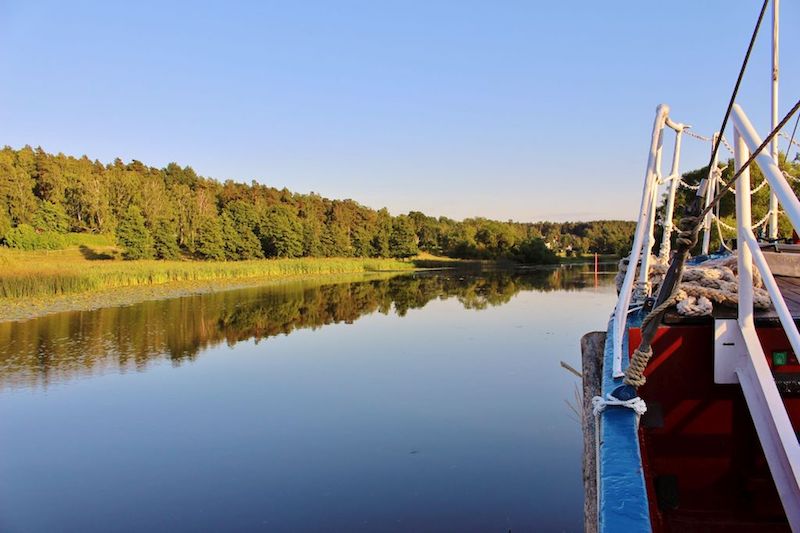
‘A place I wholeheartedly recommend’: the shrimp dinner cruise gave Rob and Kim a sense of the beautiful countryside outside Stockholm, easily accessible by steamer
Not yet a member of CRSC? Join us now for £10! Paid-up members receive CRSC’s 56-page colour magazine and the comprehensive annual Review of west coast shipping, plus discounts on special sailings, photos and DVDs, and a series of talks in Glasgow during the winter months. To join on-line today, click here.
Published on 12 August 2019












